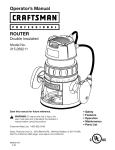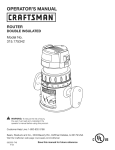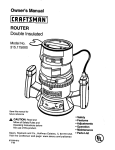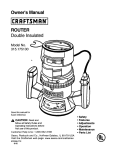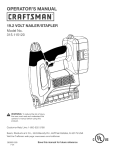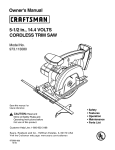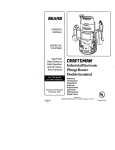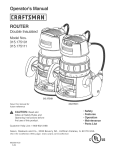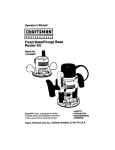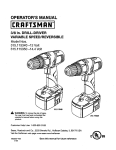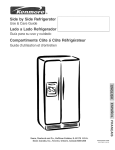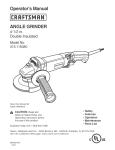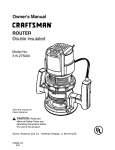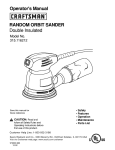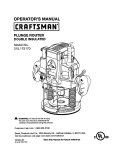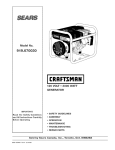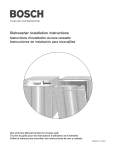Download Craftsman 315.26921 User's Manual
Transcript
CRAFTSMAN I _"° _ '°"_'1 Double Insulated Model No. 315.269210 18/32 Save this manual future reference CAU'nON: 7/16 13132 for o Safety o Features Read and follow aH Safety RuUes and Operating Rnstructions before first use of this product. Customer o Operation o Maintenance o Parts List HeUp Line: 1-800-932-3188 Sears, Roebuck and Co., 3333 Bevedy Rd., Hoffman Visit the Craftsman Web page: www.sears.com/craftsman Estates, RL 60179 USA US 983000-028 1-03 FULL ONE YEAR WARRANTY ON CRAFTSMAN PROFESSIONAL ROUTER If this rRRFTSMRN router fails due to a defect in material or workmanship within one year from the date of purchase, Sears wiii replace it, free of charge. WARRANTY SERVICE IS AVAILABLE BY SIMPLY RETURNING THE TOOL TO THE NEAREST SEARS STORE OR SEARS SERVICE CENTER IN THE UNITED STATES. This warranty gives you specific legal rights, and you may also have other rights which vary from state to state. Sears, Roebuck and Co., Dept. 817WA, Noffman Estates, IL 60179 Your router has many features for making routing operations more pleasant and enjoyable. Safety, performance and dependability have been given top priority in the design of this router making it easy to maintain and operate. ,_ Look for this symboU to point Your safety is involved. ,_ out important safety WARNING: Do not attempt to use this tool until you have read thoroughly and understand completely the operator's manual. Pay close attention to the safety rubs, including Dangers, Warnings, and Cautions. If you use your tool properly and only for what it is intended, you wiii enjoy years of safe, reliable service. precautions. It means attention!!! WARNmNG: The operation of any router can result in foreign objects being thrown into your eyes, which can result in severe eye damage. Before beginning power tool operation, always wear safety goggles or safety glasses with side shields and a full face shield when needed. We recommend Wide Vision Safety Mask for use over eyeglasses or standard safety glasses with side shields, available at Sears Retail Stores. Always wear eye protection which is marked to comply with ANSI Z87.1. 2 WARNING:Readandunderstand aH instructions. FailuretofollowaHinstructions HstedbeUow, mayresuUt in eUectric shock,fire and/orseriouspersonalinjury. SAVE THESE WORK INSTRUCTmONS AREA [] Keep your work area ctean and well Jit. CUuttered benches and dark areas invite accidents. [] Do not operate power tooJs in expJosive atmospheres, such as in the presence of flammable tiquids, gases, or dust. Power tooUs may create sparks which may ignite the dust or fumes. [] Keep bystanders, children, and visitors away while operating a power tool. Distractions can cause you to lose control. ELECTRICAL SAFETY [] DoubJe insuJated tools are equipped with a polarized pJug (one blade is wider than the other). This plug will fit in a polarized outlet onty one way. If the pJug does not fit fully in the outlet, reverse the ptug. mfit still does not fit, contact a qualified electrician to install a poJarized outtet. Do not change the plug in any way. Double insulation [] eliminates the need for the three-wire grounded power cord and grounded power supply system. [] Avoid body contact with grounded surfaces, such as pipes, radiators, ranges, and refrigerators. There is an increased risk of electric shock if your body is grounded. [] Don't expose power tools to rain or wet conditions. Water entering a power tool will increase the risk of electric shock. [] Do not abuse the cord. Never use the cord to carry the tooJs or pull the pJugfrom an outlet. Keep cord away from heat, oH, sharp edges, or moving parts. Replace damaged cords immediately. Damaged cords increase the risk of electric shock. [] When operating a power tool outside, use an outdoor extension cord marked "W-A" or "W". These cords are rated for outdoor use and reduce the risk of electric shock. PERSONAL SAFETY [] Stay alert, watch what you are doing and use common sense when operating a power toot. Do not use tooJ while tired or under the infJuence of drugs, alcohoJ, or medication. A moment of inattention while operating power tools may result in serious personal injury. [] Dress property. Do not wear Joose clothing jewelry. Contain tong hair. Keep your hair, or clothing, and gloves away from moving parts. Loose clothes, jewelry, or long hair can be caught in moving parts. Avoid before on the switch accidentaJ starting. Be sure switch is off plugging in. Carrying tools with your finger switch or plugging in tools that have the on, invites accidents. Remove adjusting keys or wrenches before turning the tooJ on. A wrench or a key that is left attached to a rotating part of the tool may result in [] Do not overreach. Keep proper footing and baJance at aH times. Proper footing and balance enables better control of the tool in unexpected situations. Do not use on a ladder or unstable support. [] Use safety equipment. AJways wear eye protection. Dust mask, non-skid safety shoes, hard hat, or hearing protection must be used for appropriate conditions. TOOL USE AND CARE [] Use cJamps or other practical way to secure and support the workpiece to a stabJe platform. Holding the work by hand or against your body is unstable and may lead to loss of control. [] Do not force toot. Use the correct toot for your application. The correct tool will do the job better and safer at the rate for which it is designed. [] Do not use tool if switch does not turn it on or off. Any tool that cannot be controlled with the switch is dangerous and must be repaired. [] Disconnect the ptug from power source before making any adjustments, changing accessories, or storing the tool Such preventive safety measures reduce the risk of starting the tool [] Store idle tools out of the reach of children and other untrained persons. Tools are dangerous in the hands of untrained users. [] Maintain tools with care. Keep cutting tools sharp and cJean. Properly maintained tools with sharp cutting edges are less likely to bind and are easier to control. [] Check for misalignment or binding of moving parts, breakage of parts, and any other condition that may affect the tooJ's operation. If damaged, have the tool serviced before using. Many accidents are caused by poorly maintained tools. [] Use only accessories that are recommended by the manufacturer for your model. Accessories that may be suitable for one tool, may become hazardous when used on another tool. SERVICE [] TooJservicemustbe performed only by qualio fied repair personnel. Service or maintenance performed by unqualified personnel could result in a risk of injury. NoJd tooJ by insulated contact hidden wiring ADDITIONAL RULES [] When servicing a tooJ, use only identicaJ reo pJacement parts. Follow instructions in the Maintenance section of this manual Use of unauthorized parts or failure to follow Maintenance hstructions may create a risk of eUectric shock or injury. gripping surfaces when performing an operation where the cutting tool may or its cord. Contact with a "live" wire will make exposed metal parts of the tool "live" and FOR SAFE OPERATmON [] Know your power tool Read operator's manuaJ carefully. Learn its appJications and limitations, as wen as the specific potentiaJ hazards related to this tool Following this rule will reduce the risk of electric shock, fire, or serious injury. [] AJways wear safety glasses. Everyday eye° glasses have onJy impact-resistant tenses; they are NOT safety gJasses. Following this rule wiii reduce the risk of serious personal injury. [] Make sure your extension cord is in good condition. When using an extension cord, be sure to use one heavy enough to carry the current your product wilt draw. A wire gage size (A.W.G.) of at Jeast 16 is recommended for an extension cord 100 feet or tess in bngth. A cord exceeding 100 feet is not recommended, if in doubt, use the next heavier gage. The smaller the gage number, the heavier the cord. An undersized cord will cause a drop in line voltage resulting in loss of power and overheating. [] Protect your lungs. Wear a face or dust mask if the operation is dusty. Following this rule wiii reduce the risk of serious personal injury. [] inspect for and remove aH nails from tumber before routing. Following this rule wiii reduce the risk of serious personal injury. [] Protect your hearing. Wear hearing protection during extended periods of operation. Following this rule will reduce the risk of serious personal injury. [] Drugs, aJcohoJ, medication. Do not operate tool while under the influence of drugs, aJcohot, or any medication. Following this rule wiii reduce the risk of electric shock, fire, or serious personal injury. [] inspect toot cords periodically and, if damaged, have repaired at your nearest authorized sero vice center. Constantly stay aware of cord location. Following this rule will reduce the risk of electric shock or fire. [] Save these instructions. Refer to them freo quentJy and use them to instruct others who may use this tool ff you Joan someone this toot, toan them these instructions also. [] Check damaged parts. Before further use of the tool, a guard or other part that is damaged should be carefully checked to determine that it wilt operate properly and perform its intended function. Check for aJignment of moving parts, binding of moving parts, breakage of parts, mounting, and any other conditions that may affect its operation. A guard or other part that is damaged shouJd be property repaired or reo placed by an authorized service center. Following this rule will reduce the risk of shock, fire, or serious injury. ,& [] Do not abuse cord. Never carry the tool by the cord or yank it to disconnect it from the recepo tac[e. Keep cord away from heat, oiJ, and sharp edges. Following this rule wiii reduce the risk of electric shock or fire. WARNING: Some dust created by power sanding, sawing, grinding, drilling, and other construction activities contains chemicals known to cause cancer, birth defects or other reproductive harm. Some examples of these chemicals are: o lead from bad-based paints, o crystalline silica from bricks and cement and other masonry products, and o arsenic and chromium treated lumber. from chemically- Your risk from these exposures varies, depending on how often you do this type of work. To reduce your exposure to these chemicals: work in a well ventilated area, and work with approved safety equipment, such as those dust masks that are specially designed to filter out microscopic particles. important: Some of the following symbols may be used on your tool. Please study them and barn their meaning. Proper interpretation of these symbols wiii allow you to operate the tool better and safer. SYMBOL NAME DESmGNATmON/EXPLANATmON V Volts Voltage A Amperes Current Hz Hertz Frequency (cycles per second) W Watt Power Minutes Time Alternating Current Type or a characteristic of current No Load Speed Rotational speed, at no load Class H Construction Designates double-insulated construction tools min no ._/min Revolutions or Reciprocation Per Minute Revolutions, strokes, surface speed, orbits etc. per minute Safety Alert Undicates danger, warning or caution. Utmeans attention!!! Your safety is involved. Wet Conditions Alert Do not expose to rain or use in damp locations. The purpose of safety symbols is to attract your attention to possible dangers. The safety symbols, and the explanations with them, deserve your careful attention and understanding. The safety warnings do not by themselves eliminate any danger. The instructions or warnings they give are not substitutes for proper accident prevention measures. SYMBOL MEANmNG DANGER: Failure to obey a safety warning will result serious shock injury to yourself or toinjury. others. Always follow the safety precautions to reduce the risk of fire,inelectric and personal WARNmNG: to obey a safetytowarning result in serious yourself or to injury. others. Always follow Failure the safety precautions reduce can the risk of fire, electricinjury shockto and personal CAU'NON: Failure Always to obey follow a safety may result toinreduce property or electric personalshock injuryand to yourself or to others. the warning safety precautions thedamage risk of fire, personal injury. NOTE: Advises you of information or instructions vital to the operation or maintenance of the equipment. SAVE THESE iNSTRUCTiONS Depth of Cut CoHet Horsepower input 0 - 1-1/2 in. 1/2 in. and 1/4 in. 2 No Load Speed Power Cord Net Weight 15,000 - 25,000/min 10 ft. 7 Ibs=6 oz= 120 volts, 60 Hz, AC only, 9.5 amps Your router has been shipped completely assembled. Unspect it carefully to make sure no breakage or damage has occurred during shipping. Rfany parts are damaged or missing, contact your nearest Sears Retail Store to obtain replacement parts before attempting to operate router. A wrench, a 1/4 in. collet assembly, and this operator's manual are also included= ,_ WARNING: Rfany parts are missing, do not operate this tool until the missing parts are replaced. Failure to do so could result in possible serious personal injury. DOUBLE iNSULATION DEPTH DouMe insulation is a concept in safety in eUectric power tooUs, which eliminates the need for the usuaU three-wire grounded power cord. AH exposed metaU parts are isoUated from the internaU metaU motor components with protecting insuUafion. DouMe insuUated tooUsdo not need to be grounded. The depth adjusting ring allows you to adjust the depth of cut. Important: Servicing of a tooUwith douMe insuUafion requires extreme care and knowUedge of the system and shouUd be performed onUyby a qualified service technician. For service, we suggest you return the tooU to your nearest authorized service center for repair. AUways use original factory replacement parts when servicing. CHIP SHIELD _ WARNmNG: The double insulated system is intended to protect the user from shock resulting from a break in the tool's internal wiring. Observe all normal safety precautions to avoid electrical shock. ELECTRICAL CONNECTmON Your router has a precision built electric motor, mt should be connected to a power suppJy that is 120 voJts, 60 Hz, AC onJy (normal househoJd current). Do not operate this toot on direct current (DO}. A substantial voltage drop will cause a loss of power and the motor will overheat. If your tool does not operate when plugged into an outlet, double-check the power supply. SWmTCH To turn the router ON, toggle the switch to the l position. To turn the router OFF, toggle the switch to the O position. SPINDLE LOCK The spindle lock secures the spindle while you make adjustments and acts as a retainer to keep the router body from coming out of the base. ADJUSTmNG LOCKING RING ARM The locking arm secures the motor housing in the base. A clear plastic chip shield is installed on the front of your router for protection against flying dust and chips. The shield is designed to fit the opening of the router base. If necessary to remove chip shield, squeeze the tabs on each end and pull outward. To replace, squeeze the tabs at each end, fit into opening, then release. For your protection, do not use router without chip shietd properly in pJace. Peel the horsepower label from chip shield and discard. VARIABLE SPEED Your router has advanced electronic features, designed to assist you in getting the maximum use from your router. By making proper speed selections, your router can be adjusted to specific routing needs. This eliminates much of the guess work previously needed to perform a given job. Both the experienced and inexperienced router users benefit, obtaining professional like results with fewer job errors. The variable speed control allows the router speed to be adjusted from 15,000 to 25,000 RPM. The variable speed control selector is conveniently located on the top of the motor housing. Speed can be set according to the approximate cutter diameter you will be using and to the hardness of the material being cut. The best cuts are made when the cutter is fed through material at the proper rate of feed. VACUUM ATTACHMENT The vacuum attachment allows you to attach a standard shop vacuum to the router for easy clean up. HANDLE POWER HANDLE WRENCH 1/4in. COLLET ASSEMBLY DEPTH ADJUSTING LOCKING ARM SPINDLE LOCK COLLET NUT ,_ Fig:1 WARNmNG: Do not allow familiarity with your router to make you careUess, Remember that a careUess fraction of a second is sufficient to inflict severe injury, 8 _ WARNING:YourroutershouUd neverbe connectedtopowersuppUy whenyouare assembfing parts,makingadjustments, installing or removingcutters,cbaning,or whennotin use.Disconnecting routerwHU preventaccidentaU startingthatcouUd causeseriouspersonaU injury. INSTALUNG/RE_OVmNG CUTTERS [] Lay router down on table to gain easy access to collet nut. [] Place wrench provided onto collet nut and turn couterclockwise to loosen. _l WARNING: Rfyou are changing a cutter immediately after use, be careful not to touch the cutter or collet with your hands or fingers. They will get burned because of the heat buildup from cutting. Always use the wrench provided. See Figure 2. [] Unplug your router. ,_ WARNING: Failure to unplug your router could result in accidental starting causing serious [] Depress spindle lock. ,_ [] To install cutter: Insert shank of cutter into collet. The shank of the cutter should be close to but not touching bottom of collet. [] To remove cutter: Remove cutter from collet. NOTE: The 1/2 in. collet is machined to precision tolerances to fit cutters with 1/2 in. diameter shanks. The 1/4 in. collet is machined to precision tolerances to fit cutters with 1/4 in. diameter shanks. WARNING: To prevent damage to the spindle or spindle lock, always allow motor to come to a complete stop before engaging spindle lock. CUTTER COLLET NUT TO LOOSEN COLLETNUT [] Tighten the collet nut securely by turning clockwise with wrench provided. [] Release spindle lock. WRENCH ,_. WARNING: Do not use cutters with undersized shanks. Undersized shanks wiii not tighten properly and could be thrown from tool causing injury. 1/4in. COLLET ASSEMBLY 1/2 in. COLLET ASSEMBLY TOTIGHTEN COLLETNUT DEPRESS SPINDLELOCK Fig. 2 CUTTERWiTH1/4 in. SHANK DIAMETER CUTTERWiTH1/2 in. SHANK DIAMETER ADJUSTmNG DEPTHOF CUT [] Turn the depth indicator ring until the zero fines up with the indicator point on the base. See F_gure 5. See Figures 3, 4, 5, and 6. We recommend that cuts be made at a depth not exceeding 1/8 in. and that several passes be made to reach depths of cut greater than 1/8 in. [] Unplug your router. _ WARNING: Failure to unplug your router could result in accidental starting causing serious [] Place router on a fiat surface and loosen locking arm. See Figure 3. CUTTERAT ZERO DEPTHOFCUT LOCKING ARM LOOSEN Fig. 5 [] Position router so that the cutter can extend below the subbase for desired depth setting. See Figure 6. Fig. 3 [] Turn depth adjusting ring until cutter is inside subbase. See Figure 4. [] Turn depth adjusting ring until tip of cutter touches fiat surface. TO RAISE CUTTER TO LOWER CUTTER \ CUTTEREXTENDED BELOWSUBBASE DEPTH ADJUSTING RiNG iNDICATOR POINT CUTTER iNSiDESUBBASE [] Turn the depth adjusting ring to obtain the desired depth of cut. The distance the cutter moves can be read on the depth adjusting ring. Each mark on the depth adjusting ring indicates 1/32 inch change in depth setting, indicator point is located on the base. DEPTH iNDiCATOR RiNG SUBBASE Fig. 6 [] Tighten locking arm securely. Fig. 4 10 ADJUSTING DEPTH The speed selecfion chart shown gives suggested speed settings based on the diameter of the cutter and the type of materiai being routed, OF CUT (WroTH ROUTER See Figure 7. We suggest that you practice with the variabie speed feature of your router before instaiHng a cutter and making cuts in wood, The indicator point on the base can be used when using your router mounted to a router tame, [] Set the cutter at zero depth of cut, [] Rotate depth indicator ring to desired depth of cut on the scab, Refer to "ADJUSTING DEPTH OF CUT" earlier in this manual SPEED SELECTION CHART CUTTER SIZE [] Tighten Hocking arm secureiy, MATERIAL 1/4 3/8 1/2 3/4 FOR ROUTER TABLE USE ONLY INDICATOR POINT DEPTH ADJUSTMENTRING Fig, 7 ADJUSTING SPEED See Figure 8. Your router has a variabHe speed eontroH seHector designed to aHHowoperator controH of speed and torque iimits. You can make speed selections best suited to the type of cut, the materiai being cut, and the size of bit being used. The variabie speed controi selector allows you to adjust router speed from 15,000 to 25,000 RPM. There is a six-step scab (A to F) on the variabHe speed controH seHector. To increase the speed and torque of your router, turn the variable speed control selector to a higher setting (F). Turn to a lower setting to decrease speed and torque. Fig. 8 iNSTALLiNG THE VACUUM ATTACHMENT [] Place the vacuum attachment in the area at the rear of the router under the Hocking arm. [] Secure the vacuum attachment with the two screws provided. NOTE: If you do not want to use the variable speed control selector, turn it to the highest possible setting, and the feature will not be active. 11 HELPFUL 7" HINTS AUways damp workpbce STARTING/STOPPING [] Grasp handles using both hands, See Figure 9. secureUy before routing, V" A safe operator is one who thinks ahead, V" AUways wear eye protection when routing, 7" Make setup adjustments carefully, Then doubb check, Measure twice and cut once, 7" Keep cutters dean and properUy sharpened, 7" Don't bt familiarity make you carebss, 7" Study aH safety rubs and do the job safeUy, [] To start muter: Press the switch to the 1position, See Figure 10. [] To stop muter: Press the switch to the O position, See Figure 10. HANDLE V" Never pUaceyour hands in jeopardy, V" Make certain damps can't bosen while in use, 7" Test difficuUt setups on scrap -- Don't waste Uumber. 7" PUaneach operation before you begin, 7" Provide for smoother operation by cleaning your ROUTER POWER HANDLE router frequendy, Shake router or Mow with an air jet to remove sawdust buildup, 7" Think safety by thinking ahead. Fig. 9 (0 )TO STOP (I) TO START SWITCH Fig. 10 12 PLACINGROUTERON WORKPIECE FEEDING PUacing your router on a workpbce differs, depending on the type of routing: edge routing or internaU routing. The "secret" of professional routing and edge shaping lies in making a careful set-up for the cut and in selecting the proper rate of feed. _ RATE OF FEED WARNING: Remain alert and watch what you are doing. Do not operate router when fatigued. The proper rate of feed depends on several factors: the hardness and moisture content of the wood, the depth of cut, and the cutting diameter of the bit. When cutting shallow grooves in soft woods such as pine, a faster rate of feed can be used. When making deep cuts in hardwoods such as oak, a slower rate of feed should be used. EDGE ROUTING [] Place router on edge of workpiece, making sure the router bit does not contact workpiece. [] Turn router on and let motor build to its full speed. [] Begin your cut, gradually feeding cutter into workpiece. _ The best rate of feed is one that does not slow down the router motor more than one-third of its no-load WARNING: Keep a firm grip on router with both hands at aii times. Failure to do so could result in speed. If the router is fed too fast, it will take large chips out of the wood and leave gouge marks, ff the router is fed too slow, it wiii scorch or burn the wood. loss of control leading to possible serious injury. [] Upon completion of cut, turn motor off and let it come to a complete stop before removing router from work surface. ,_ Feeding Too Fast Clean, smooth routing and edge shaping can be done only when the bit is revolving at a relatively high speed and is taking very small bites to produce tiny, cleanly severed chips. If your router is forced to move forward too fast, the RPM of the bit becomes slower than normal in relation to its forward movement. As a WARNING: Never pull router out of work and place upside down on work surface before the cutter stops. INTERNAL result, the bit must take bigger bites as it revolves. "Bigger bites" mean bigger chips, and a rougher finish. Bigger chips also require more power, which could result in the router motor becoming overloaded. ROUTING [] Tilt router and place on workpiece, letting edge of subbase contact workpiece first. Under extreme force-feeding conditions the relative RPM of the bit can become so slow--and the bites it NOTE: Be careful not to let router bit contact workpiece. has to take so large -- that chips will be partially knocked off (rather than fully cut off), resulting in splintering and gouging of the workpiece. See Figure 11. [] Turn router on and let motor build to its full speed. [] Feed cutter into workpiece gradually until subbase is level with workpiece. ,_ Your router is an extremely high-speed tool (15,000 25,000 RPM no-load speed), and will make clean, smooth cuts if allowed to run freely without the overload of a forced (too fast) feed. Three things that cause "force feeding" are bit size, depth-of-cut, and workpiece characteristics. The larger the bit or the deeper the cut, the more slowly the router should be advanced. Rfthe wood is very hard, knotty, gummy or damp, the operation must be slowed still more. WARNING: Keep a firm grip on router with both hands at all times. Failure to do so could result in loss of control leading to possible serious injury. [] Upon completion of cut, turn motor off and let it come to a complete stop before removing router from work surface. _ ROUTER WARNING: Never pull router out of work and place upside down on work surface before the cutter stops. You can always detect "force feeding" by the sound of the motor. Its high-pitched whine will sound lower and stronger as it loses speed. Also, the strain of holding the tool will be noticeably increased. 13 DIRECTION (EXTERNAL) See Figure 12. Feeding Too Slow Utis aBo possiMe to spoil a cut by moving the router forward too sbwUy. When it is advanced into the work too sbwUy, a revoMng bit does not dig into new wood fast enough to take a bite; instead, it simpUy scrapes away sawdust-Hke partbbs. Scraping produces heat, which can gUaze, burn, or mar the cut and in extreme cases, can even overheat the bit so as to destroy its hardness. The router motor and bit revolve in a clockwise direction. This gives the tool a slight tendency to twist (in your hands) in a counterclockwise direction, especially when the motor revs up (as at starting). Because of the extremely high speed of bit rotation during a "proper feeding" operation, there is very little kickback to contend with under normal conditions. However, should the bit strike a knot, hard grain, foreign object, etc. that would affect the normal progress of the cutting action, there will be a slight kickback--sufficient to spoil the trueness of your cut if you are not prepared. Such a kickback is always in the direction opposite to the direction of bit rotation. Unaddition, it is more difficuUt to controU a router when the bit is scraping instead of cutting. With practically no bad on the motor the bit wHUbe revoMng at dose to top RPM, and wHUhave a much greater than normaU tendency to bounce off the sides of the cut (especially if the wood has a pronounced grain with hard and soft areas). As a result, the cut produced may have rippled, instead of straight sides. See Figure 11. To guard against such a kickback, plan your setup and direction of feed so that you will always be thrusting the tool--to hold it against whatever you are using to guide the cut--in the same direction that the leading edge of the bit is moving. In short, the thrust should be in a direction that keeps the sharp edges of the bit continuously biting straight into new (uncut) wood. "Too-slow feeding" can also cause your router to take off in a wrong direction from the intended line of cut. Always grasp and hoJd your router firmly with both hands when routing. You can detect "too-slow feeding" by the runaway, high-pitched sound of the motor; or by feeling the "wiggle" of the bit in the cut. sT PROPER CUTTING SEQUENCE 4 TOOFAST Fig. 12 TOOSLOW Fig. 11 14 DIRECTION (INTERNAL) Wheneveryouareroutinga groove,yourtravel shouldbeina directionthatplaceswhateverguide youareusingat theright-hand side.Inshort,when theguideis positioned as shownin thefirstpartof Figure13,tooltravelshouldbeleftto rightand counterclockwise aroundcurves.Whentheguideis positionedasshowninthesecondpartof Figure13, tooltravelshouldberighttoleftandclockwisearound curves.Rtfhereis a choice,thefirstsetupis generally theeasiesttouse.Ineithercase,thesidewaysthrust youuseis againsttheguide. GUIDE OUTSIDE ROTATION THRUST DEPTH OF CUT As previously mentioned, the depth of cut is important because it affects the rate of feed that, in turn, affects the quality of the cut (and, also, the possibility of damage to your router motor and bit). A deep cut requires a slower feed than a shallow one, and a too deep cut will cause you to slow the feed so much that the bit is no longer cutting, it is scraping, instead. Making a deep cut is never advisable. The smaller bits -- especially those only 1/16 inch (1.6 mm) in diameter -- are easily broken off when subjected to too much side thrust. A large enough bit may not be broken, but if the cut is too deep a rough cut will result -- and it may be very difficult to guide and control the bit as desired. For these reasons, we recommend that you do not exceed 1/8 in. depth of cut in a single pass, regardless of the bit size or the softness or condition of the workpiece. See FiXTure 14. To make deeper cuts it is therefore necessary to make as many successive passes as required, lowering the bit 1/8 in. for each new pass. In order to save time, do all the cutting necessary at one depth setting, before lowering the bit for the next pass. This will also assure a uniform depth when the final pass is completed. See FiXTure 15. ROTATION FEED DETERMINING GUIDE DEPTH OFCUT GUIDE INSIDE __ WIDTH ROTATION C_ GUIDE @ ÷ THRUST Fig. 14 ROTAT OH FEED / 1ST. Fig. 13 2HD. [7 PASS PASS _U m 2ND.PASS Fig. 15 15 ROUTING Yourrouterisa versatiletooUandcarlbeusedfor marlydifferentappHcations. Youmayroutgrooves, carvedesignsusinga tempUate, carvedesignsby freehand,tapertaNeandchairUegs, mortisedoor jambs,orcreatejoints. ROUTING GROOVES See Figure 16. When routing across the face of boards, set router at desired depth of cut, pUacethe edge of router base against workpiece, and turn on the router. SbwUy feed the cutter into the workpiece along desired Hne of cuL ,_ WARNING: If desired depth of cut is greater than can be safeUy cut in one pass, make cuts in two or more passes, Fig, 16 When routing straight cuts across stock, damp a straight edge to the workpiece to use as a guide, Position the straightedge parallel to the line of cut and offset the distance between the cutting edge of the cutter and the edge of the router base, Hold the router base against the straightedge and rout the groove, Rout the pattern in two or more passes, Make the first pass at 25% of the desired depth of cut, This will provide better control as well as being a guide for the next pass, NOTE: Do not rout deeper than 1/8 in, per pass, When routing a groove wider than the diameter of the cutter, clamp a straightedge on both sides of the cutlines, Position both guides parallel to the desired line of cut and spaced equal distances from the desired edges of the groove, Rout along one guide; then, reverse direction and rout along the other guide, Clean out any remaining waste in the center of the ,_ WARNING: Do not use large router bits for freehand routing. Use of large router bits when freehand routing could cause loss of control or create other hazardous conditions that could cause possible serious personal injury. When using a router table, large router bits should be used for edging only. Do not use router bits that are larger in diameter than the opening in router base for any purpose. ROUTING BY FREEHAND See F_Ture 17. When used freehand, your router becomes a flexible and versatile tool. This flexibility makes it possible to easily rout signs, relief sculptures, etc. There are two basic techniques for freehand routing: [] Routing letters, grooves, and patterns into woo& [] Routing out the background, leaving the letters or pattern raised above the surface. When freehand routing, we suggest the following: [] Draw or layout the pattern on workpiece. [] Choose the appropriate cutter. NOTE: A core box or V-groove bit is often used for routing letters and engraving objects. Straight bits and ball mills are often used to make relief carvings. Veining bits are used to carve small, intricate detail& Fig, 17 16 ROUTING WITHGUIDEBUSHINGS WhenusingtheTempUate GuideBushingsItemNo.925082withyourrouter,youmustvisuallycenterthe bitwiththebushingbeforebeginning yourcut.Your routersubbasemaybeadjustedby boseningthe screwshoUding thesubbasetoyourrouter.Besureto tightenbcHngarmbeforecenteringbit in bushing. Aftercenteringbitwithbushing,tightenscrews secureUy. EDGINGWITHPILOTBITS TOPEDGESHAPING See Figure 18. Arbor-type bits with pilots are excellent for quick, easy, edge shapinga They wHUfollow workpbce edges that are either straight or curved. The pilot prevents the bit from making too deep a cut; and hoUding the pilot firmUy in contact with the workpbce edge throughout prevents the cut from becoming too shallow. Go,oE Whenever the workpiece thickness together with the desired depth of cut (as adjusted by router depth setting) are such that only the top part of the edge is to be shaped (leaving at bast a 1/16 inch thick uncut portion at bottom), the pilot can ride against the uncut portion, which wiii serve to guide it. See Figure /8. However, if the workpiece is too thin or the bit set too low so that there will be no uncut edge to ride the pilot against, an extra board to act as a guide must be placed under the workpiece. This "guide" board must have exactly the same contour -- straight or curved -- as the workpiece edge. If it is positioned so that its edge is flush with the workpiece edge, the bit will make a fuji cut (in as far as the bit radius). On the other hand, if the guide is positioned as shown in Figure 18 (out from the workpiece edge), the bit will make less than a full cut -- which will alter the shape of the finished edge. WHOLE EDGE SHAPING Fig. 18 NOTE: Any of the piloted bits can be used without a pilot for edge shaping with guides, as preceding. The size (diameter) of the pilot that is used determines the maximum cut width that can be made with the pilot against the workpiece edge - the small pilot exposes all of the bitl the large one reduces this amount by 1/16 inch. 17 _ WARNING:Whenservicing,useonUy idenficaU CraftsmanrepUacement parts.Useofanyother partmaycreatea hazardor causeproduct damage. GENERAL Orfiythe partsshownonthepartsHst,areintendedto berepairedor repUaced by thecustomer.AHother partsrepresentan importantpartofthedouMe insuUafion systemandshouUd beservicedonUy bya qualifiedSearsservicetechnician. AvoidusingsoUvents whencleaningpUasfic parts. MostpUastics aresuscepfiMe todamagefromvarious typesofcommerdaU soUvents andmaybedamaged bytheiruse.UsedeancUoths toremovedirt,carbon dust,etc. COLLET Dustandchipsmaycollectonthecolletfromtimeto time,makingit necessarytocleanthecollet.Todo so,removethecolletassemblyandwipeit witha cleandryrag.Cleanthetaperintheshaftin thesame manner.Neverimmersethecolletor endoftheshaft in a solventor inwater.Beforereplacingthecollet assembly, puta dropof SAE30motoroilonthe inside ofthenut,onthethreadsoftheshaft,andon the taperintheshaft.Replacethecolletassemblyonto theshaftbyhandonly.Nevertightenthecolletnut withouta bit inthecollet.Thisactioncould permanently damagethecollet. LUBRICATION _1_ WARNING:Donotat anytimeUetbrakefluids, gasoline,petroleum-based products,penetrating oils,etc.comeincontactwithplasticparts.They containchemicals thatcandamage,weakenor destroyplastic. It hasbeenfoundthatelectrictoolsaresubjectto accelerated wearandpossibleprematurefailurewhen theyareusedonfiberglassboats,sportscars, wallboard,spacklingcompounds, or plaster.The chipsandgrindingsfromthesematerialsarehighly abrasivetoelectrictoolpartssuchasbearings, brushes,commutators, etc.Consequently, it is not recommended thatthistoolbeusedforextended workonanyfiberglassmaterial,wallboard,spackling compounds, or plaster.Duringanyuseonthese materialsit is extremely importantthatthetoolis cleanedfrequentlyby blowingwithanairjet. CUTTERS Getfastermoreaccuratecuttingresultsbykeeping cutterscleanandsharp.Removeallaccumulated pitchandgumfromcuttersaftereachuse. Whensharpening cutters,sharpenonlytheinsideof thecuttingedge.Nevergrindtheoutsidediameter.Be surewhensharpening theendof a cutterto grindthe clearance anglethesameas originallyground. All of the bearings in this tool are lubricated with a sufficient amount of high grade lubricant for the life of the unit under normal operating conditions. Therefore, no further hJbrication is require& EXTENSION The use of any extension cord will cause some loss of power. To keep the loss to a minimum and to prevent tool overheating, use an extension cord that is heavy enough to carry the current the tool will draw. A wire gage size (A.W.G.) of at least 14 is recommended for an extension cord 100 feet or less in length. When working outdoors, use an extension cord that is suitable for outdoor use. The cord's jacket will be marked WA ,_ CAUTION: Keep extension cords away from the cutting area and position the cord so that it will not get caught on lumber, tools, etc. during _ WARNING: Check extension cords before each use. If damaged replace immediately. Never use tool with a damaged cord since touching the damaged area could cause electrical shock resulting in serious injury. Extension cords suitable for use with your router are available at your nearest Sears Retail Store. ,_ 18 CORDS WARNING: Always wear safety goggles or safety glasses with side shields during power tool operation or when blowing dust. If operation is dusty, also wear a dust mask. THEFOLLOWING RECOMMENDED ACCESSORIES ARE CURRENTLY AVAILABLEATSEARSRETAILSTORES TempJate GuideBushings DovetailTemplate BoxJoint Template _ ROUTER WARNING: Butt HingeTemplate MuitiopurposeRouterGuide Rout- A - Form Pantograph The use of attachments oFaccessories TABLES With a router table your router is converted high-speedshaper. GUIDE not listed above might be hazardous, BUSHINGS Guide bushings allow for accurate guiding of router along any workpiece oF template edge and for grooving oF shaping of curved contours, into a WARNING: Only use router tables with proper guarding for the cutter and with "on board" switch controlled receptacles (Part No, 9-25188)= Failure to use router tables with appropriate safety features could result in serious personal 19 CRAFTSMAN ROUTER- MODEL NUMBER 315.'269210 -._ 2 SEENOTE 3 4 22 12 5 7 11 8 11 2O 18 _14 m 19 i 7 _25 24 NOTE: The assemMy shown represents an important part of the douMe insuUated system, To avoid the possibility of aUterafion or damage to the system, service shouUd be performed by your nearest Sears repair center, Contact your nearest Sears retail store for service center information, 2O CRAFTSMAN ROUTER - MODEL NUMBER 315.269210 J The number wiii regarding be found on a plate attached to the ordering motor housing. Always mention the model number | in aiimodel correspondence your ROUTER or when repair parts. SEE BACK PAGE FOR PARTS ORDEFtING iNSTRUCTiONS PARTS UST Key No. Part No. 1 983014-001 2 982899-014 3 982716-001 4 982959-001 5 703477-057 6 706382-357 7 982972-001 8 982971-002 9 982948-032 10 982990-001 11 982500-131 12 617966-030 13 983060-007 14 982379-001 15 623173-006 16 998586-001 17 612191-004 18 982993-001 19 982966-001 20 982991-001 21 982890-002 22 982890-001 23 982889-001 24 982970-001 25 643115-005 983000-028 * Standard Hardware Item -- May Be Purchased Locally ** Available from Div. 98 -- Source 980.00 21 Your Home For repair-in your home-of all major brand appliances, lawn and garden equipment, or heating and cooling systems, no matter who made it, no matter who sold it! .................. For the replacement parts, accessories and owner's manuals that you need to do-it-yourself. .................. For Sears professional installation of home appliances and items like garage door openers and water heaters. .................. 1-8 00-4-MY-H 0 ME® (1-800-469-4663) oa,, an t, o, o,oht sod Oaoada www.sears.com .......... www.sears.ca Our Home For repair of carry-in items like vacuums, lawn equipment, and electronics, call or go on-line for the location of your nearest Sears Parts & Repair Center. 1-800-488-1222 Call anytime, day or night (U.S.A. only) www.sears.com To purchase a protection agreement (U.S.A.) or maintenance agreement (Canada) on a product serviced 1-800-827-6655 Pard pedir servicio (U.S.A.) 1-800-361-6665 de reparacien Au Canada a domicilio, y para ordenar piezas. 1-8 8 8-S U- HO G AR sM by Sears: (Canada) pour service en frangais: 1 -800- LE- FO YER Mc (1-800-533-6937) (1-888-784-6427) www.sears.ca ............... .............. SEARS ® Registered Trademark / TMTrademark / SM Service Mark of Sears, Roebuck ® Marca Registrada / TM Marca de F_brica / SM Marca de Servicio de Sears, MC Marque de commerce / MD Marque d6pos6e de Sears, Roebuck and Co. and Co. Roebuck and Co. ® Sears, Roebuck and Co.






















